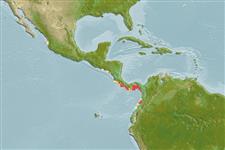>
Gobiiformes (Gobies) >
Gobiidae (Gobies) > Gobiinae
Eponymy: Charles Harvey Bollman (1868–1889) was an America naturalist principally interested in fish and myriapods, considered by Jordan to be one of the most brilliant and promising naturalists ever known despite being just 20 when he died. [...] Alfredo Gómez Gaspar is a Venezuelan marine scientist. [...] (Ref. 128868), visit book page.
Environment: milieu / climate zone / depth range / distribution range
Ecologia
marino demersale; distribuzione batimetrica 10 - 120 m (Ref. 92840). Tropical
Eastern Central Pacific: Panama and Colombia.
Size / Peso / Age
Maturity: Lm ? range ? - ? cm
Max length : 14.0 cm SL maschio/sesso non determinato; (Ref. 92840)
Short description
Chiavi di identificazione | Morfologia | Morfometria
Distinguished by the following characteristics: laterally compressed head and body; large mouth and very oblique; completely scaled body with ctenoid scales; first dorsal with VII spines; pelvic fins fused forming a disc; caudal fin lanceolate (Ref. 92840).
Inhabits sand and mud bottoms (Ref. 11482).
Life cycle and mating behavior
Maturità | Riproduzione | Deposizione | Uova | Fecundity | Larve
Allen, G.R. and D.R. Robertson, 1994. Fishes of the tropical eastern Pacific. University of Hawaii Press, Honolulu. 332 p. (Ref. 11482)
IUCN Red List Status (Ref. 130435: Version 2024-2)
Threat to humans
Harmless
Human uses
Strumenti
Special reports
Download XML
Fonti Internet
Estimates based on models
Preferred temperature (Ref.
123201): 16.1 - 26.4, mean 21.5 °C (based on 33 cells).
Phylogenetic diversity index (Ref.
82804): PD
50 = 0.5005 [Uniqueness, from 0.5 = low to 2.0 = high].
Bayesian length-weight: a=0.00724 (0.00339 - 0.01546), b=3.10 (2.92 - 3.28), in cm total length, based on LWR estimates for this (Sub)family-body shape (Ref.
93245).
Trophic level (Ref.
69278): 3.4 ±0.4 se; based on size and trophs of closest relatives
Resilienza (Ref.
120179): Alto, tempo minimo di raddoppiamento della popolazione meno di 15 mesi (Preliminary K or Fecundity.).
Fishing Vulnerability (Ref.
59153): Low vulnerability (10 of 100).
